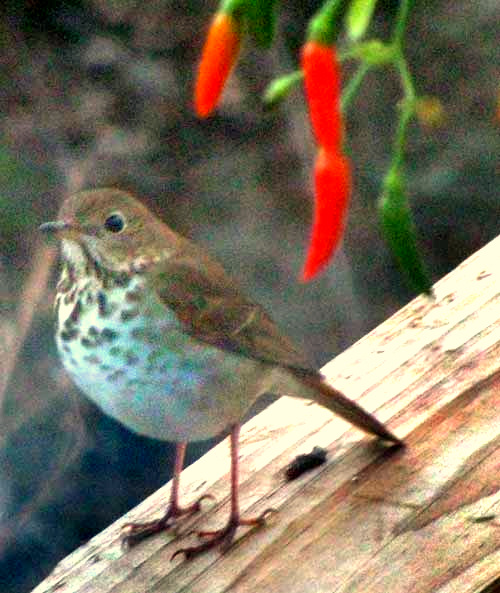Excerpts from Jim Conrad's
Naturalist Newsletter
from the January 19, 2014 Newsletter issued from the Frio Canyon Nature Education Center in the valley of the Dry Frio River in northern Uvalde County, southwestern Texas, on the southern border of the Edwards Plateau; elevation ~1750m (~5750 ft); N29.62°, W99.86°; USA
HERMIT THRUSH AT DAWN
Back during my hermit years in the Mississippi woods, Hermit Thrushes seemed to be drawn to my camp {see below}. I'm in a different world now, but nowadays often my mornings still are graced with the visit of a certain Hermit Thrush. He only comes at dawn, sometimes so early that he's just a silhouette hopping on the deck's boards. Other times he comes when there's just enough light to see the spots on his chest as he stands there looking through the window exactly at me. In morning's dim light, below you can see him next to my potted Thai Chile plant:

He looks like several other species of spotted-breasted thrushes that can turn up here, but Hermit Thrushes are the only thrush species present here during the winter. In fact, Hermits visit only during the winter. They nest in Canada, Alaska and the mountainous western US.
Actually, instead of looking at me as I took that picture, he may have been eyeing those chili peppers, for when he departed he flew straight up and touched the plant, as if swiping a pepper. He did it so fast that I couldn't see if he really got one, but he well might have. I read that in the northern US during the winter when insects are hard to come by he feeds largely on berries and buds, so he might really have wanted a chili pepper.
Some say that the Hermit Thrush's song is the most beautiful of all North American birds', and that could be right. He's not singing now, though. These mornings he seems to channel all his poetic urges into that dawn look in his eye.
from the January 19, 2003 Newsletter issued from the woods just south of Natchez, Mississippi, USA
HERMIT THRUSH
Each morning as I prepare my campfire breakfast, a Hermit Thrush, CATHARUS GUTTATUS, comes visiting. He seldom gets closer than about six feet (1.8 m), but he definitely likes to watch me from not far away. More than once he's landed on a water bucket and cocked his head sideways so that one eye seemed to look directly into my own eyes. Saturday morning he briefly landed on the table less than a yard (meter) from me as I breakfasted.
Hermit Thrushes belong to the same bird family as the American Robin, so they about a robin's size and shape (a little smaller), hop on the ground like a robin, and share with robins that curious ability to appear to hold their bodies in one place while, in a flash, their two legs below scratch the ground in tandem, stirring up insects and disconcerting earthworms. Unlike robins, Hermit Thrushes are fairly drab birds, mostly rusty-gray on their backs, with a few modest speckles on their pale breasts.
At http://www.mbr-pwrc.usgs.gov/id/framlst/i7590id.html you can click on SONG to hear a Hermit Thrush sing (Mine is silent now). If you click on BBS MAP you'll see the species' summer breeding territory, while clicking on CBC MAP will display their winter distribution. These maps show that with us Hermit Thrushes are winter residents, with an especially high concentration in a small area centered exactly here, but they spend their summers far from us.
Thrushes and thrashers should not be confused. Brown Thrashers, found here year round, are of a similar color and also bear speckled breasts, but they are in the same family as Mockingbirds and Catbirds, so they are larger birds, with much longer tails. Several thrush species visit our area, but only the Hermit Thrush is a winter resident. During summers our common thrush is the Wood Thrush, plus during migration we commonly see Swainsons and Gray-cheeked Thrushes, as well as a few Veerys, which also are thrushes.
During migration, unless you hear their songs, it can be hard to distinguish the various thrush species. The main visual fieldmark of the Hermit Thrush is its reddish tail and rump -- the rump being that part of the back right above the tail.
Of course I do not overlook the point that I am a genuine hermit each morning being visited by a genuine Hermit Thrush. Nor do I ignore Walt Whitman's lines: